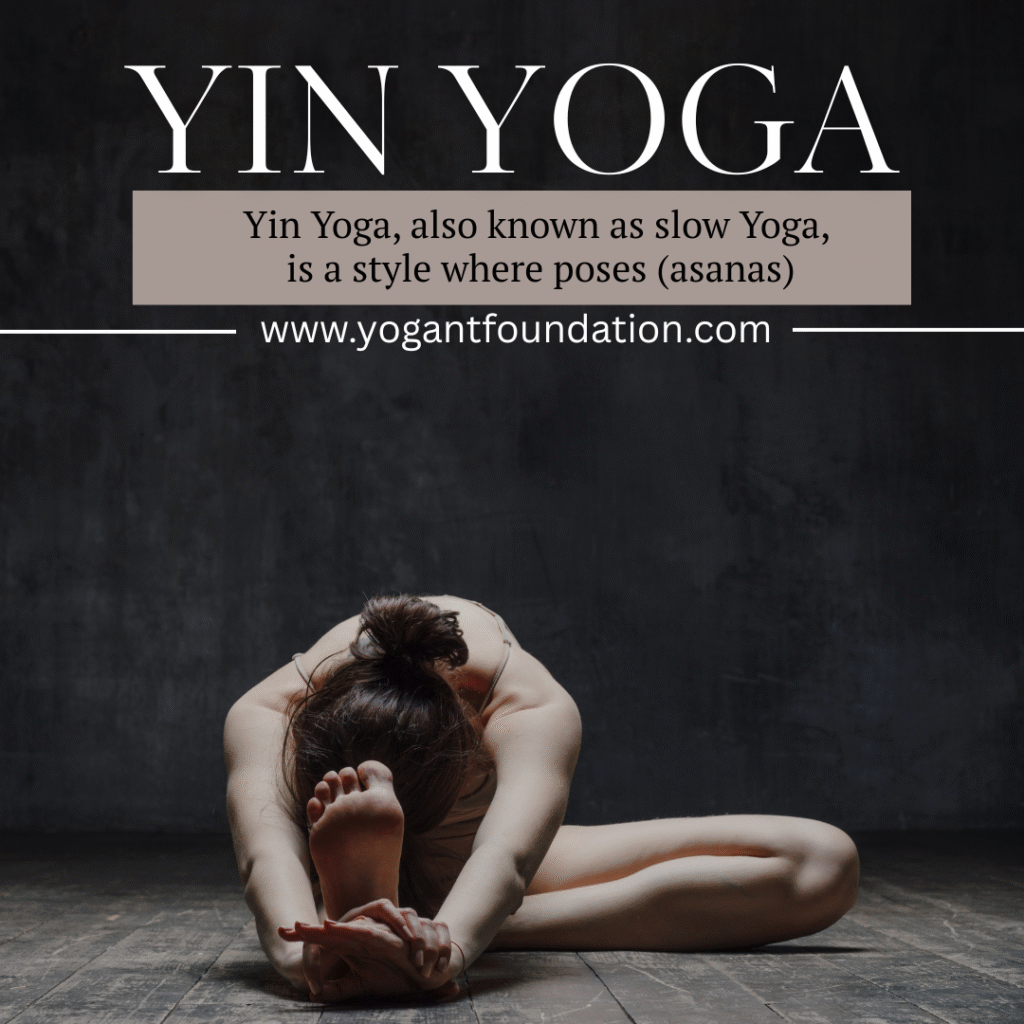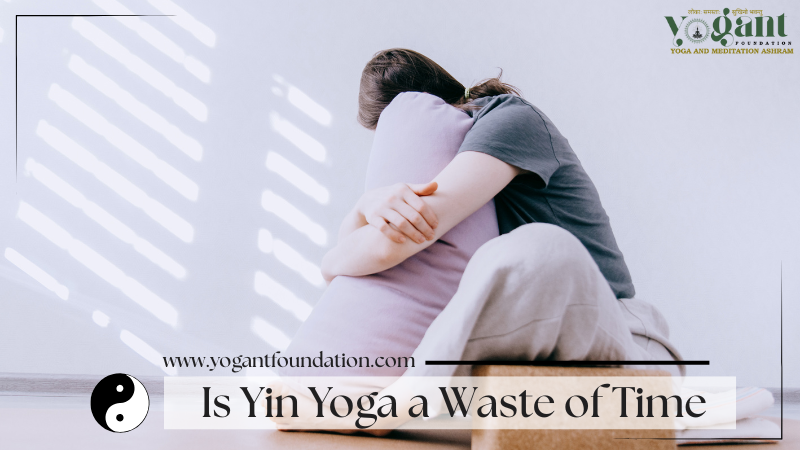The Question Everyone Asks | Is Yin Yoga a Waste of Time?
You may have heard about Yin Yoga if you’ve used your yoga mat or searched YouTube for classes. If you are a restless individual, you might have wondered: Is Yin Yoga a waste of time?
This question is often asked because Yin Yoga has a slower. More meditative pace than Vinyasa, or power yoga, which can be calorie-burning. Stillness is a foreign concept in today’s culture of “go, go, go”, where fitness can be measured by sweat or steps. But let’s face it: Yin Yoga may not be a time-waster. But instead, one of the best practices you can do for your mind, body, and emotional health.
The following article explores:
- What Yin Yoga is
- Myths about it
- Benefits that are backed by science
- It’s most powerful when used by beginners and those who are stressed.
- How to incorporate Yin Yoga into your daily life
You’ll learn why Yin Yoga is not a “waste of time”.
What is Yin Yoga exactly?
Yin Yoga, also known as slow Yoga, is a style where poses (asanas). Usually held longer than 3-7 minutes. You don’t move quickly from pose to pose. But instead, you breathe and let gravity do the work.
Characteristics of
- Stasis: Holding still is the only thing that’s required.
- Deeper tissues: Unlike the active form of Yoga, which focuses on muscles, Yin focuses on ligaments, fascia, and joints.
- Meditation and mindfulness: This practice promotes self-reflection and silence.

Yin Yoga, developed in the 20th century, is a complement to more “yang-style” forms of exercise. Such as running, weight-training, and Vinyasa Yoga, which emphasizes movement and strength.
Myths: Is Yin Yoga a Waste of Time
Myth 1: Yin Yoga is Too Slow to Be Effective
This is why most people believe is yin yoga a waste of time. Some people believe you aren’t exercising “properly” if you don’t sweat buckets.
Reality:
Calories burned are not always a good indicator of effectiveness. Yin Yoga is more effective than other forms of Yoga.
- Stretches and hydrates tissues that stiffen up with age or inactivity.
- It increases joint flexibility.
- The body can recover faster after hard workouts.
In fact, many elite athletes, from weightlifters to runners. Now, practice Yin Yoga as a way to balance their training.
Myth 2: Yin Yoga is Only for Beginners
Because Yin Yoga appears “easy”, people tend to assume. It is for beginners and those who cannot handle vigorous practice.
Reality:
It’s physically and mentally challenging to hold a position for 5 minutes. Yin yoga can be just as challenging as fast-paced, high-energy Yoga.
Imagine it as meditation. It’s easy in theory but difficult to do.
Myth 3: Yin Yoga Doesn’t Build Strength
Is yin yoga a waste of time, but it is often called “lazy” because it doesn’t involve weights or push-ups.
Reality:
Yin Yoga will not build muscle mass as weight lifting does. It develops patience, endurance, and awareness. The deep stretching engages the stabilizing muscles, which builds resilience. It also improves the ability to stop and relax. Critical skill for many Americans in our high-stress society.
Is Yin Yoga a Waste of Time | Know the Benefits of Yin Yoga
Let’s look at why Yin Yoga doesn’t waste time but is actually one of the most time-efficient practices that you can practice.
1. Relaxation & Reset Nervous System
Yin Yoga stimulates the parasympathetic system, which is also known as “rest and digest mode”. It lowers cortisol, a stress hormone. Slow, mindful movements can reduce depression and anxiety.
2. Joint health & improved flexibility
Yin stretches the fascia, and not just muscles. Over time, this enhances flexibility and prevents stiffness–especially important if you sit long hours at a desk.
3. Mind Clarity and Emotional Healing
Long holds help you learn to accept discomfort, whether it’s physical or emotional. Many practitioners have reported that during their practice, they are able to release suppressed emotions.
4. Get Better Sleep
Yin Yoga helps to treat insomnia by calming your mind and relaxing your body. Sleep quality can be improved by doing Yin Yoga for as little as 20 minutes prior to bedtime.
5. Exercises that Complement Other Workouts
If you are a runner, weight lifter, or do high-intensity fitness, Yin will balance out your “yang” activities by providing injury prevention and recovery.
Yin Yoga for Beginners: Why It’s the Perfect Start
Yoga is a great way to learn if you are new. It’s not necessary to do handstands or touch your toes. You only need patience, a yoga mat, and the willingness to breath.
The practice is safe when props such as blankets, pillows, and bolsters are used. Yin Yoga’s popularity is due to its accessibility.
- Aged
- Recovering from Injury
- The stiffness of office workers
- Does anybody get intimidated by the fast pace of a yoga class
Yin Yoga vs. Restorative Yoga: Are They the Same?
A second myth is the idea that Yin Yoga and Restorative Yoga have identical practices. Although they may look the same, they are different.
- Yin Yoga: This practice targets deep tissue with a mild strain to improve flexibility.
- Restorative Yoga: This type of Yoga uses props to promote relaxation and deep stretching without using any heavy stretching.
Restorative focuses on relaxation, whereas Yin is more focused on structural advantages.
How Yin Yoga Helps in Daily American Life
In the USA, balancing family life, work, and technology is a common challenge. Yin Yoga directly addresses these challenges.
- To soothe the nervous system after long working hours, Yin calms down.
- Improves spine mobility for back pain caused by desk jobs.
- To calm anxiety caused by constant social media and news, Yin provides a mindful rest.
- For gym-goers and athletes: Yin promotes healing and helps prevent burnout.
Common Poses in Yin Yoga
You can start with these beginner-friendly Yin Yoga positions:
- The Butterfly Pose (Baddha Konasana). Opens the hips and stretches the inner thighs.
- Dragon Pose– A deep hip opener for athletes and runners.
- Caterpillar pose– Forward folding for the hamstrings, spine, and thighs.
- Sphinx Position– A gentle backbend strengthens the spine.
- Shoelace Pose – Intense hip stretch.
Keep in mind that it’s more important to stay than how far you travel.
Tips to Get the Most Out of Yin Yoga
- Props: Use cushions and bolsters to make holding long positions comfortable.
- Focus on exhalation to relax.
- Be consistent. You should practice at least twice per week.
- Have patience, you will reap the benefits over time.
Final Verdict: Is Yin Yoga a Waste of Time?
No. Yin Yoga does not waste time. It’s an Investment in Long-Term Health. It may not provide you with six-pack abs or even a high from a sweaty exercise, but it does offer something more: Stress relief, emotional equilibrium, flexibility, and inner strength.
Yin Yoga is a powerful reminder that in a world obsessed with productivity and speed, slowing down may be our most effective action.
Conclusion: Is Yin Yoga a waste of time
Slow but Powerful :
The next time someone says that Yin Yoga is boring or useless, remember this: Stillness isn’t weakness. Yin Yoga helps Americans to reconnect with their inner selves in a fast-paced world.
Yin Yoga is a great way to recover from an injury or for beginners. It’s not a time-waster, but it could be your most effective use of time.
FAQs About Yin Yoga
1. Really Is Yin Yoga a waste of time?
Yin Yoga has a high level of effectiveness. Although it doesn’t burn calories like high-intensity workouts, Yin Yoga improves connective tissue, increases flexibility, calms down the nervous system, and reduces stress. Yin Yoga can be a valuable practice for people who are dealing with back pain or have tight muscles due to sitting all day.
2. Who should practice Yin Yoga?
Yin Yoga can be beneficial for everyone, including beginners, aged, and office workers. It is also great for athletes or anyone who has stiffness, stress, or challenges with their joints. It is safe for everyone and can be adapted to suit almost any situation. Consult your doctor if you suffer from serious medical conditions or joint problems.
3. How often should I do Yin Yoga?
The majority of people can benefit from Yin Yoga when they practice it 2-3 times per week. One session per week will make a difference to your flexibility, sleep, and stress levels. If you are already doing intense exercises, Yin can be the ideal recovery technique to balance out your workout routine.
4. Is Yin Yoga safe for beginners?
Yin Yoga can be done by beginners. Poses are easy to do, and you can use props such as bolsters or blankets. Beginners need to listen to their bodies and avoid overstretching.
5. How is Yin Yoga different from Restorative Yoga?
Yin Yoga uses gentle pressure on fascia, joints, ligaments, and muscles to increase flexibility. Restorative Yoga is all about relaxation, using props to achieve total relaxation without stressing the tissues. Yin’s stillness is active, while Restorative Yoga is all about rest.
6. Does Yin Yoga build strength?
Not the way you think of it. Yin Yoga instead builds patience and mental endurance. This strengthens the stabilizing muscles and increases body awareness.
7. Can Yin Yoga help with anxiety and sleep problems?
Yes. Yin Yoga helps to reduce cortisol and calms the mind by activating the parasympathetic system. In the USA, many people use Yin Yoga as an evening exercise to relieve stress and improve their sleep.
8. Is Yin Yoga good for weight loss?
Indirectly, yes. Yin Yoga does not burn many calories, but reduces stress, which can lead to weight gain. It also improves hormone balance and supplements active exercises. Weight management is made easier by calming your nervous system.
9. How long are Yin Yoga poses held?
The majority of Yin Yoga positions are held between 3-7 minutes. Advanced practitioners may stay even longer. It is important to allow the connective tissue to relax and improve mobility.
10. Can I do Yin Yoga every day?
Yes, many people practice Yin Yoga daily. Be sure to pay attention to what your body is telling you. You can alternate Yin Yoga with Hatha or Vinyasa if your body feels sore.
Read Blog: 20 Benefits of Yoga: A Complete Guide to Transformation



